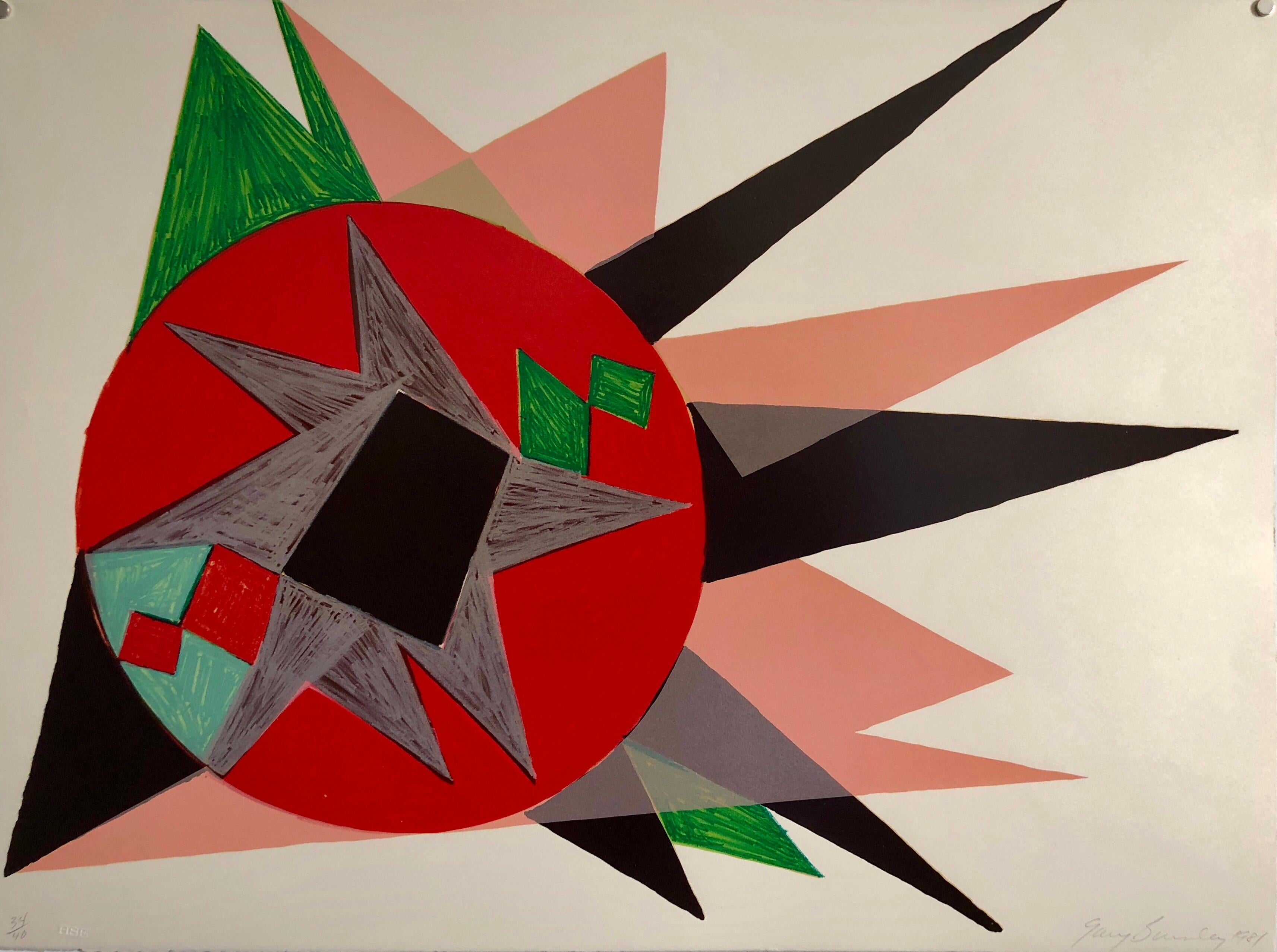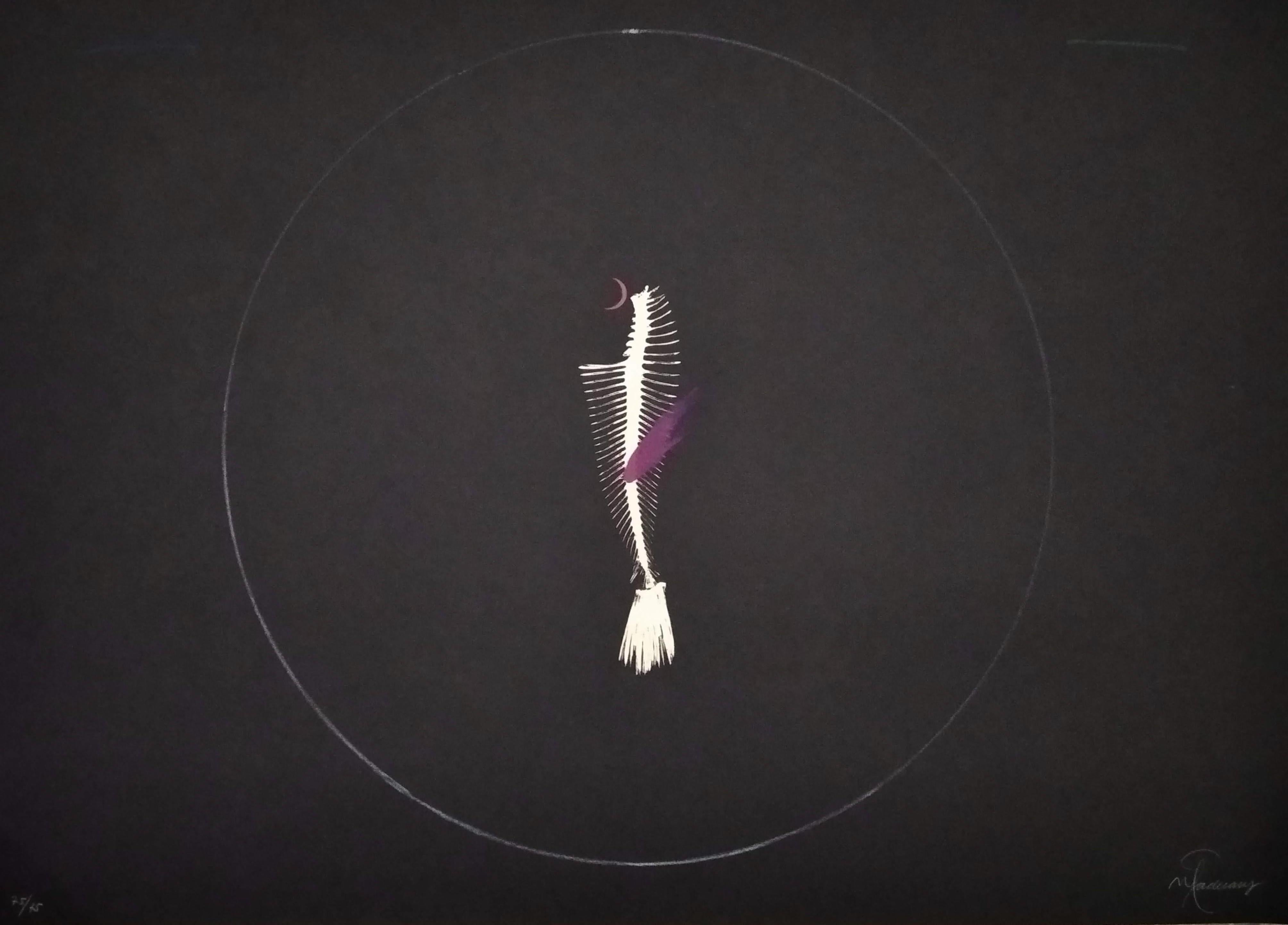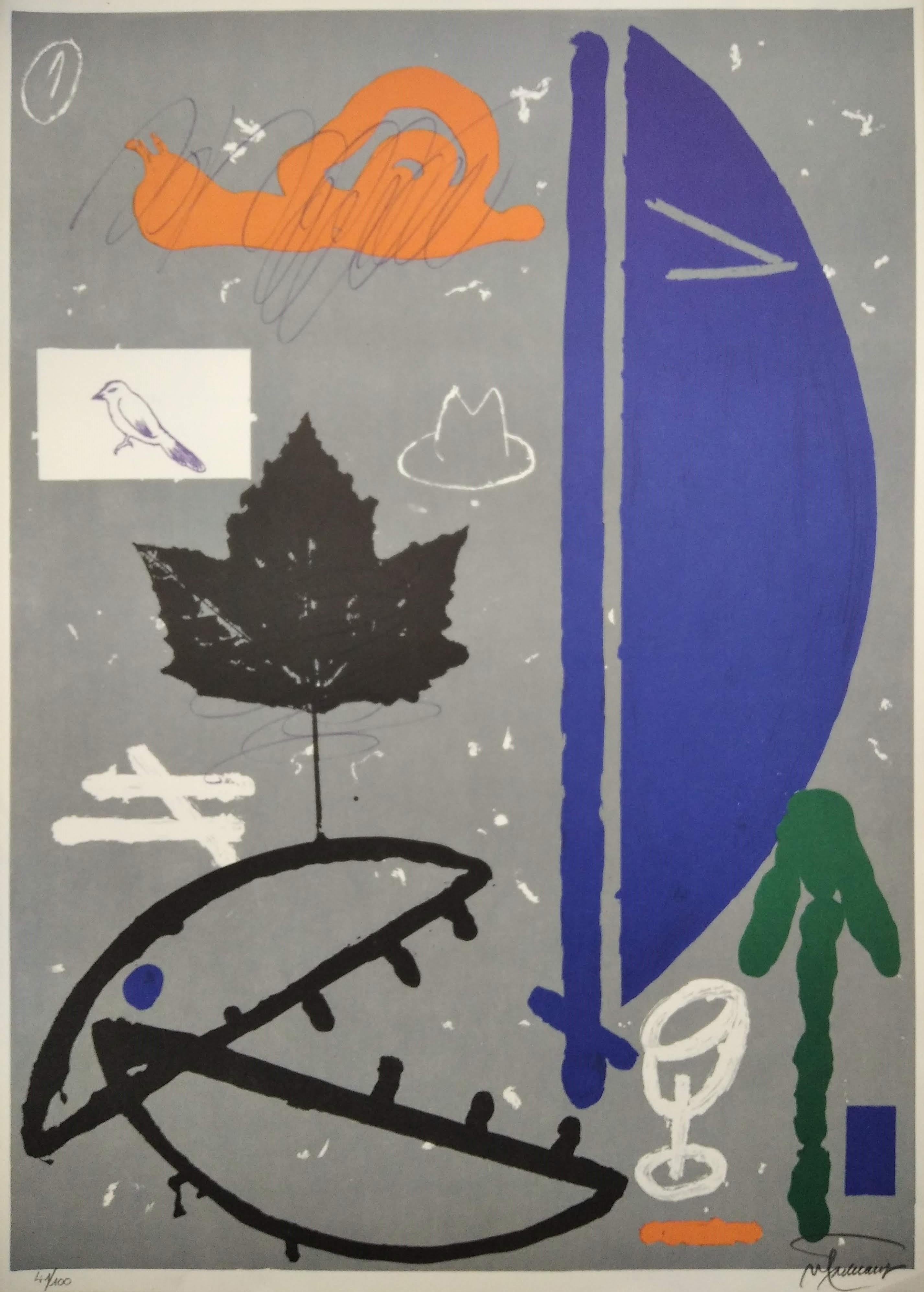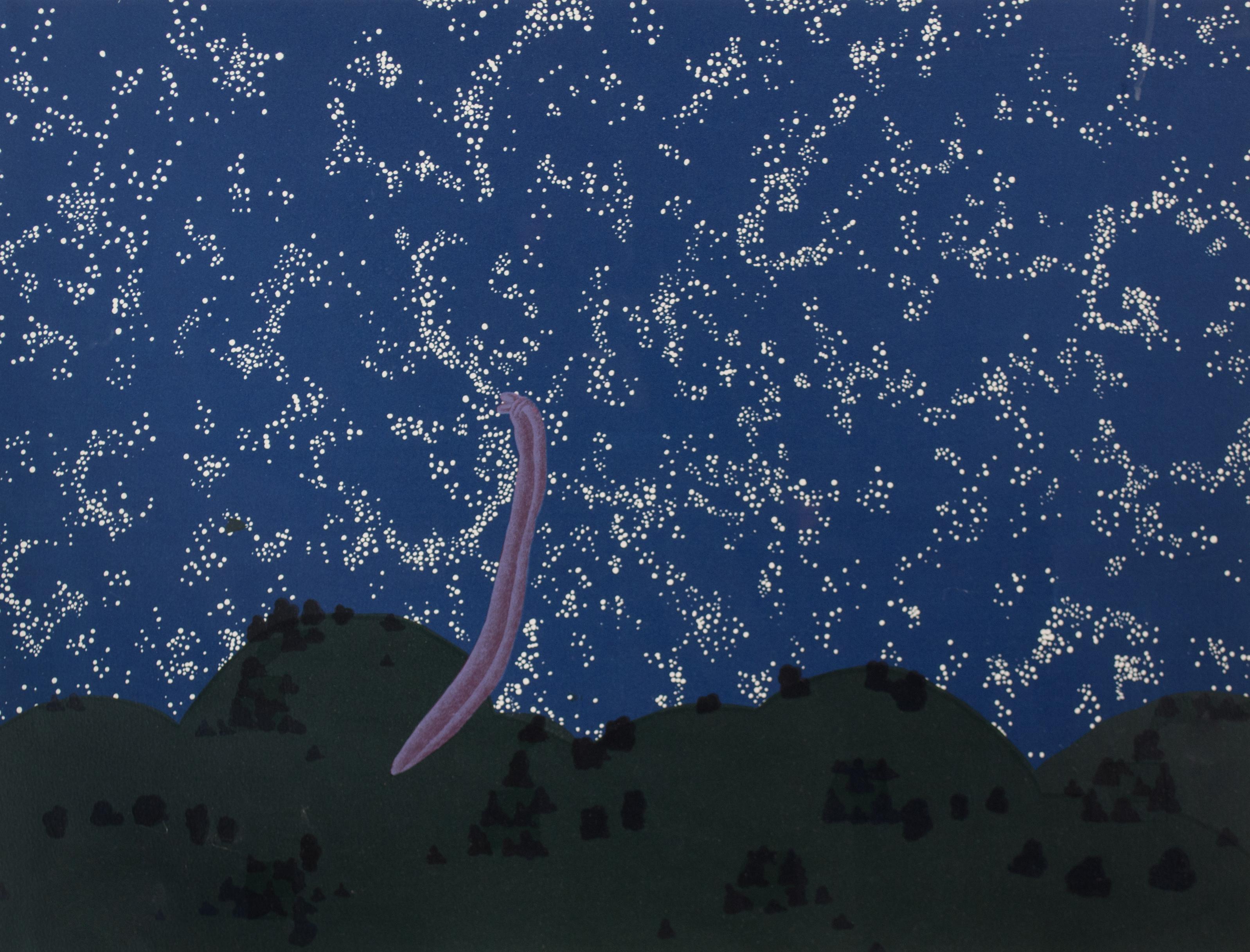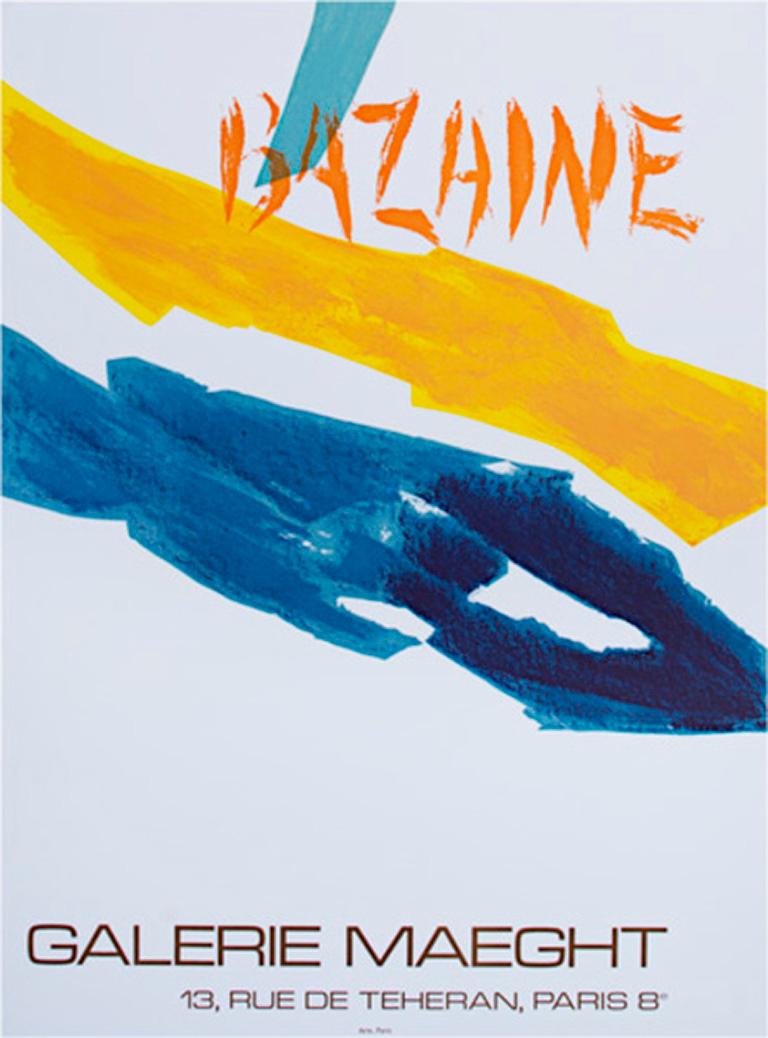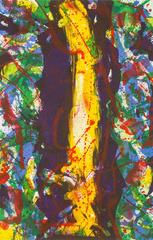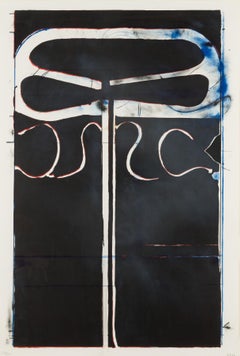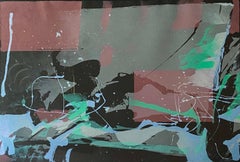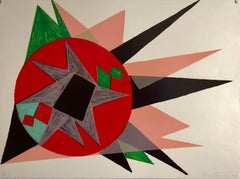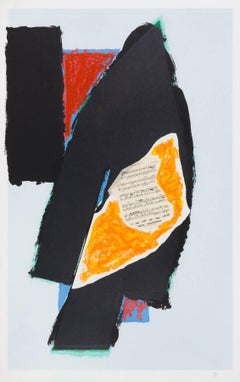
Black for Mozart
View Similar Items
Robert MotherwellBlack for Mozart1991
1991
About the Item
- Creator:Robert Motherwell (1915-1991, American)
- Creation Year:1991
- Dimensions:Height: 59.88 in (152.1 cm)Width: 38.19 in (97.01 cm)
- Medium:
- Movement & Style:
- Period:
- Condition:
- Gallery Location:San Francisco, CA
- Reference Number:Seller: G 280561stDibs: LU912852053
Robert Motherwell
The name of painter, printmaker and writer Robert Motherwell (1915–91) is often taken as synonymous with the New York School, whose name he coined. Motherwell was the youngest of this group of Abstract Expressionists working in art, dance, poetry and music in 1950s and '60s New York City, which included Jackson Pollock, Willem de Kooning, Philip Guston, Helen Frankenthaler and Mark Rothko.
Born in Aberdeen, Washington, in 1915, Motherwell had perhaps the broadest and best education of any of the New York School coterie, with an extensive background in philosophy, literature and art history. He earned a BA in philosophy in 1937 from Stanford University and was working toward a PhD in the subject at Harvard when he interrupted his studies for a yearlong trip to Europe, where he fell in love with European modernism.
After returning, in 1940 he enrolled Columbia to study art history. It was there that he met a group of exiled Parisian Surrealists, and encounter that proved influential on his style. Motherwell began to integrate the idea of “automatism” — unmediated gestures that reflect deeper psychological impulses — into his work, pioneering a new form of Abstract Expressionism that came to characterize the New York School.
Works like the 1967 Beside the Sea no. 45, an acrylic on canvas, and the 1966 lithograph New York International epitomize Motherwell’s use of simple shapes in boldly contrasting colors, executed in quick, gestural strokes that occasionally evoke figures, suggesting a latent narrative despite their obvious abstraction.
Throughout his career, Motherwell taught painting at Hunter College, in New York, and at Black Mountain College, in North Carolina, where his work influenced the likes of Cy Twombly, Robert Rauschenberg and Kenneth Noland. His influence as one of the founding fathers of American Abstract Expressionism remains profound.
- Untitled (SF-343)By Sam FrancisLocated in San Francisco, CAOriginal lithograph printed in six colors (light yellow, golden yellow, yellow-green, light ultramarine blue, purple, red on PTI #120 Waterleaf wove paper. Hand-signed in pencil l...Category
1990s Abstract Abstract Prints
MaterialsLithograph
Price Upon Request - Untitled (from Club/Spade Group ’81-82)By Richard DiebenkornLocated in San Francisco, CAOriginal lithograph printed in 6 colors on Arches Cover wove paper Hand-signed with the artist’s monogram and dated in pencil at the lower right sheet tip RD82. A superb impression of the definitive state, from the edition of 250, numbered in pencil at the lower left sheet tip. One of 8 plates by various artists from the portfolio Eight by Eight to Celebrate the Temporary Contemporary, published by The Museum of Contemporary Art, Los Angeles; printed by Krystine Graziano, Kenneth Farley, Alan Holoubek, James Reid...Category
1980s Post-War Abstract Prints
MaterialsLithograph
Price Upon Request - Sky SwirlBy Alexander CalderLocated in San Francisco, CASigned with the artist’s monogram and dated on the stone lower right CA 74. A superb impression of the definitive state, from the edition commissioned by Braniff International Air...Category
20th Century Abstract Geometric Abstract Prints
MaterialsLithograph
Price Upon Request - Concert Hall Set IIIBy Sam FrancisLocated in San Francisco, CAOriginal lithograph printed in 6 colors (yellow, yellow-green, light blue, magenta, turquoise, dark blue) from 6 aluminum plates on BFK Rive wove paper Hand-signed in pencil lower r...Category
1970s Abstract Abstract Prints
MaterialsLithograph
Price Upon Request - Concert Hall Set IIIBy Sam FrancisLocated in San Francisco, CAOriginal lithograph printed in 6 colors (yellow, yellow-green, light blue, magenta, turquoise, dark blue) from 6 aluminum plates on BFK Rive wove paper Hand-signed in pencil lower r...Category
1970s Post-War Abstract Prints
MaterialsLithograph
Price Upon Request - Untitled (SF-343)By Sam FrancisLocated in San Francisco, CAOriginal lithograph printed in 6 colors (light yellow, golden yellow, yellow-green, light ultramarine blue, purple, red on PTI #120 Waterleaf wove paper Hand-signed in pencil lower ...Category
1990s Post-War Abstract Prints
MaterialsLithograph
Price Upon Request
- “Shore Sentry”By Syd SolomonLocated in Southampton, NYShore Sentry, is an original color, limited edition lithograph on handmade German black etching paper; printed by Topaz Editions in 1977. Artist proofs 10. Edition size 100. Provenance:: A Sarasota, Florida collector Signed: Artist signed lower left with edition size Image size: 22 by 30 inches Sheet size: 30 by 38 inches Edition 38/100 Condition: Excellent Overall framed size: 30.25 by 38.25 inches Framed under plexiglass in chrome colored metal gallery frame SYD SOLOMON BIOGRAPHY Written by Dr. Lisa Peters/Berry Campbell Gallery “Here, in simple English, is what Syd Solomon does: He meditates. He connects his hand and paintbrush to the deeper, quieter, more mysterious parts of his mind- and he paints pictures of what he sees and feels down there.” --Kurt Vonnegut Jr. from Palm Sunday, 1981 Syd Solomon was born near Uniontown, Pennsylvania, in 1917. He began painting in high school in Wilkes-Barre, where he was also a star football player. After high school, he worked in advertising and took classes at the Art Institute of Chicago. Before the attack on Pearl Harbor, he joined the war effort and was assigned to the First Camouflage Battalion, the 924th Engineer Aviation Regiment of the US Army. He used his artistic skills to create camouflage instruction manuals utilized throughout the Army. He married Ann Francine Cohen in late 1941. Soon thereafter, in early 1942, the couple moved to Fort Ord in California where he was sent to camouflage the coast to protect it from possible aerial bombings. Sent overseas in 1943, Solomon did aerial reconnaissance over Holland. Solomon was sent to Normandy early in the invasion where his camouflage designs provided protective concealment for the transport of supplies for men who had broken through the enemy line. Solomon was considered one of the best camoufleurs in the Army, receiving among other commendations, five bronze stars. Solomon often remarked that his camouflage experience during World War II influenced his ideas about abstract art. At the end of the War, he attended the École des Beaux-Arts in Paris. Because Solomon suffered frostbite during the Battle of the Bulge, he could not live in cold climates, so he and Annie chose to settle in Sarasota, Florida, after the War. Sarasota was home to the John and Mable Ringling Museum of Art, and soon Solomon became friends with Arthur Everett “Chick” Austin, Jr., the museum’s first Director. In the late 1940s, Solomon experimented with new synthetic media, the precursors to acrylic paints provided to him by chemist Guy Pascal, who was developing them. Victor D’Amico, the first Director of Education for the Museum of Modern Art, recognized Solomon as the first artist to use acrylic paint. His early experimentation with this medium as well as other media put him at the forefront of technical innovations in his generation. He was also one of the first artists to use aerosol sprays and combined them with resists, an innovation influenced by his camouflage experience. Solomon’s work began to be acknowledged nationally in 1952. He was included in American Watercolors, Drawings and Prints at the Metropolitan Museum of Art, New York. From 1952–1962, Solomon’s work was discovered by the cognoscenti of the art world, including the Museum of Modern Art Curators, Dorothy C. Miller and Peter Selz, and the Whitney Museum of American Art’s Director, John I. H. Baur. He had his first solo show in New York at the Associated American Artists Gallery in 1955 with “Chick” Austin, Jr. writing the essay for the exhibition. In the summer of 1955, the Solomons visited East Hampton, New York, for the first time at the invitation of fellow artist David Budd. There, Solomon met and befriended many of the artists of the New York School, including Jackson Pollock, Franz Kline, Willem de Kooning, James Brooks, Alfonso Ossorio, and Conrad Marca-Relli. By 1959, and for the next thirty-five years, the Solomons split the year between Sarasota (in the winter and spring) and the Hamptons (in the summer and fall). In 1959, Solomon began showing regularly in New York City at the Saidenberg Gallery with collector Joseph Hirshhorn buying three paintings from Solomon’s first show. At the same time, his works entered the collections of the Whitney Museum of American Art, the Solomon R. Guggenheim Museum, and the Wadsworth Athenaeum in Hartford, Connecticut, among others. Solomon also began showing at Signa Gallery in East Hampton and at the James David Gallery in Miami run by the renowned art dealer, Dorothy Blau. In 1961, the Guggenheim Museum’s H. H. Arnason bestowed to him the Silvermine Award at the 13th New England Annual. Additionally, Thomas Hess of ARTnews magazine chose Solomon as one of the ten outstanding painters of the year. At the suggestion of Alfred H. Barr, Jr., the Museum of Modern Art’s Director, the John and Mable Ringling Museum in Sarasota began its contemporary collection by purchasing Solomon’s painting, Silent World, 1961. Solomon became influential in the Hamptons and in Florida during the 1960s. In late 1964, he created the Institute of Fine Art at the New College in Sarasota. He is credited with bringing many nationally known artists to Florida to teach, including Larry Rivers, Philip Guston, James Brooks, and Conrad Marca-Relli. Later Jimmy Ernst, John Chamberlain, James Rosenquist, and Robert Rauschenberg settled near Solomon in Florida. In East Hampton, the Solomon home was the epicenter of artists and writers who spent time in the Hamptons, including Alfred Leslie, Jim Dine, Ibram Lassaw, Saul Bellow...Category
1970s Post-Modern Abstract Prints
MaterialsHandmade Paper, Lithograph
- Lithograph w Gloss Overprinting Stacked Signs Post Modern 80s Memphis Milano EraLocated in Surfside, FLUntitled, 1981 (Stacked Signs Series) lithograph with Glosscote overprinting. Published by Holly Solomon Editions. (original gallery label photo is included for reference and not included in sale) Hand signed and numbered from limited edition of 40. This is a beautiful piece perfect for the Memphis Milano early 1980's Post Modern Era. It also bears influence from Pop Art (Particularly Allan D'Arcangelo) Gary Burnley...Category
1980s Post-Modern Abstract Prints
MaterialsLithograph
- The Songs of the Blacks and the BluesBy Louise BourgeoisLocated in Ljubljana, SIThe Songs of the Blacks and the Blues. Original color lithograph, woodcut, gouache and oil-stick editions, 1996. Edition of 40 signed and numbered impressions on Arches paper. Louise...Category
1990s Post-Modern Abstract Prints
MaterialsMixed Media, Gouache, Lithograph, Woodcut
Price Upon Request - Italian Post Modern Pop Art Lithograph Silkscreen Valerio Adami Galerie MaeghtBy Valerio AdamiLocated in Surfside, FLTitled Ledoux, color limited edition lithograph. Hand signed by artist in pencil to right hand corner, 101/150 to left. 19.5" X 14" print view area. This is done in a Postmodernist, Memphis Milano style. Valerio Adami (born 17 March 1935) is an Italian painter. Educated at the Accademia di Brera in Milan, he has since worked in both London and Paris. His art is influenced by Pop Art. Adami was born in Bologna. In 1945, at the age of ten, he began to study painting under the instruction of Felice Carena. He was accepted into the Brera Academy (Accademia di Brera) in 1951, and there studied as a draughtsman until 1954 in the studio of Achille Funi. In 1955 he went to Paris, where he met and was influenced by Roberto Matta and Wifredo Lam. His first solo exhibition came in 1959 in Milan. In his early career, Adami's works were expressionistic, but by the time of his second exhibition in 1964 at Kassel, he had developed a style of painting reminiscent of French cloisonnism, featuring regions of flat color bordered by black lines. Unlike Gauguin, however, Adami's subjects were highly stylized and often presented in fragments. In the 1970s, Adami began to address politics in his art, and incorporated subject matter such as modern European history, literature, philosophy, and mythology. In 1971, he and his brother Giancarlo created the film Vacances dans le désert. In 1974 he illustrated a Helmut Heissenbuttel poem, Occasional Poem No. 27. Ten Lessons on the Reich with ten original lithographs {Galerie Maeght}. In 1975, the philosopher Jacques Derrida devoted a long essay, "+R: Into the Bargain", to Adami's work, using an exhibition of Adami's drawings as a pretext to discuss the function of "the letter and the proper name in painting", with reference to "narration, technical reproduction, ideology, the phoneme, the biographeme, and politics". The Galerie Maeght is a gallery of modern art in Paris, France, and Barcelona, Catalonia, Spain. The gallery was founded in 1936 in Cannes. The Paris gallery was started in 1946 by Aimé Maeght. The artists exhibited are mainly from France and Spain. Since 1945, the gallery has presented the greatest modern artists such as Matisse, Bonnard, Braque, Miró, and Calder. In 1956, Adrien Maeght opened a new parisian venue. The second generation of “Maeght” artists was born: Bazaine, Andre Derain, Giacometti, Kelly, Raoul Ubac, then Riopelle, Antoni Tapies, Pol Bury and Adami, among others. There were four retrospective exhibits of Adami's work between 1985 and 1998. They were held in Paris, the Centre Julio-Gonzalez de Valence (Spain), Tel Aviv, and Buenos Aires. In 2010, the Boca Raton Museum of Art devoted a special exhibit to Adami's Post Modern paintings and drawings. Derriere le Miroir, the editor was Aimé Maeght. Derrière le Miroir is a French art magazine created in 1946 and published until 1982...Category
1980s Post-Modern Landscape Prints
MaterialsLithograph
- OlympiaBy Friedensreich HundertwasserLocated in Ljubljana, SIOriginal signed color poster lithograph, 1983. Edition of 150 signed and numbered impressions on Arches paper. Art and Sport portfolio: The Yugoslav Olympic Committee of the Winter O...Category
1980s Post-Modern Abstract Prints
MaterialsLithograph
- UntitledLocated in Barcelona, ESIncludes a Certificate of AuthenticityCategory
Early 2000s Post-Modern Abstract Prints
MaterialsLithograph

